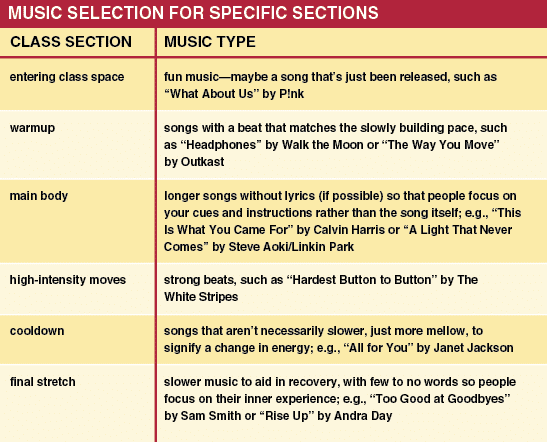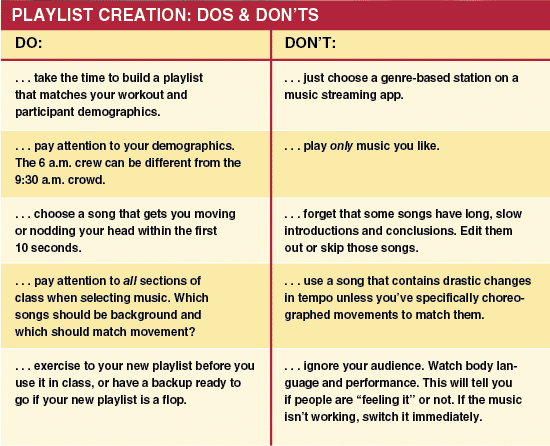The Power of a Playlist
A good workout includes solid programming and on-point music.

There was a time when I was teaching 32 group classes per week for 14 companies, all with different demographics and with classes spread throughout the city. It wasn’t uncommon for me to teach in a collegiate setting, a fitness facility, a studio, a corporate office and a hospital, all in the same day. Could I have used the same generic fitness mix for every location or simply chosen a station on a music streaming app? Sure, if I’d been content to deliver a subpar experience. However, the right music motivates and inspires people to move, and I wanted to cater to each population and format. I therefore created a playlist for every class.
When you teach many different classes, it’s easy to get complacent about music. Apps like Pandora and Spotify make it very tempting to choose a genre-based station and hit “play”; however, if you spend a little time developing custom playlists, you can create magic.
Read on to find out more about the three most important things to consider when building playlists: demographics, song selection and song order (or sequencing).
Know Your Demographics
Knowing the general makeup of the classes you teach is vital. Are participants mostly one gender, or is there a mix? Are they in their 20s and 30s or in their 50s and 60s? Is the gym or studio downtown or in the suburbs? Take these factors into account when selecting music. It’s fine to introduce one or two new songs from genres people may not listen to regularly, but in general it’s smarter to stick with what they know and love.
Always remember that it’s their workout, not yours. You cater to their wants and needs in your programming; why should it be any different with your playlists? No matter how much you love a new song, if no one in the room wants to move to it, it doesn’t make the cut. Know your market and read your audience.
Song Selection and Sequencing Matter!
There are many great tunes to choose from, but that doesn’t mean you can throw them together haphazardly. An hourlong playlist usually consists of approximately 16 songs. Here are my suggestions, based on factors I consider when selecting and sequencing songs. See the sidebar “Music Selection for Specific Sections” for more.
Start off on the right note. Play music as people enter the workout space. This sets the scene, conveying a shift in energy and letting people know that it’s time to move and have fun. I usually select a newly released song (or two) that a lot of people are excited about.
Warm them up. Select two songs for the warmup so that people have enough time to get ready for the workout. I usually choose one recent, popular single and one “oldie but goodie” tune people never seem to tire of. The pace of these songs shouldn’t be too quick, but they should make participants want to move. You get bonus points for songs that haven’t been overplayed on local radio stations.
Take time to focus. For the “meat and potatoes” section, choose songs that aren’t lyric-heavy or readily recognizable—you want people to focus on your coaching and not sing along to familiar choruses. In other words, you want their attention to be on movement quality, not on song lyrics. Beats per minute will obviously vary depending on the workout, but for most strength or interval classes, the tempo can be 126–144 bpm.
Shift for the intervals. For energy changes and bursts, or if you want people to move with the beat, choose any song with a fast, well-defined beat that’s easy to follow and amps up the energy. I usually prefer a song around 140 bpm, give or take.
Go hard; don’t go home. When you want people to go all out—the “Rocky Balboa” moment—choose an inspirational song with significant power. Tempo doesn’t matter as much here, but do select a tune that elicits emotion.
Tame the transition. For the segment before the actual cooldown, while you’re doing core exercises or mobility work, choose one or two fun songs you’ve known for a while—maybe top hits from several years ago. Any genre will do, but use something less powerful than the inspirational finisher.
Bring it down. For the cooldown itself, select at least two songs to ensure people stretch adequately. Bring on the slow jams! Slower-paced songs accelerate recovery rates (Lee & Kimmerly 2016).
Best Practices (Let Go of Your Ego)
Sometimes the songs you choose sound great when you’re listening to them but not when you hear them over the sound system in class. I recommend working out to a new playlist before using it with participants. This lets you gauge how well songs work. Even so, it’s a good idea to include a couple of extra tracks in your playlist (before the cooldown music starts) in case a song turns out to be a dud and you have to skip it. My fallbacks are typically songs I’ve used before that I know people like.
Read your audience! This is a key skill to develop. If your crew’s energy isn’t where you want it, the music may be the culprit. Therefore, have an entire album as a backup just in case, and make sure that it’s premixed or that you’ve used it in the past and know it will work.
Finally, don’t get overinvested in your playlist. Keep your ego out of it, and don’t be hurt if people don’t like your music. Instead, ask for suggestions. This is a great way to tap into your clients’ tastes; it also takes some pressure off you to constantly search for great tunes. When I was creating all those playlists for classes around the city, I’d sometimes get burned out and ask my participants for their favorites. I’d get so many responses that I’d hardly have to do any digging.
Your keen programming and expert coaching are vital parts of a successful group fitness class, but never underestimate the power of a playlist. Take the time to get to know your participants and to select music that will motivate them to move with mastery and fun.
References
Aquatic Exercise Association. 2014. Standards and guidelines: Aquatic fitness programming. Accessed Sept. 2017: https://www.aeawave.com/Portals/2/PDF/AEA_Standards_and_Guidelines14.pdf.
Becker, B.E. 2009. Aquatic therapy: Scientific foundations and clinical rehabilitation applications. PM&R, 1 (9), 859–60.








